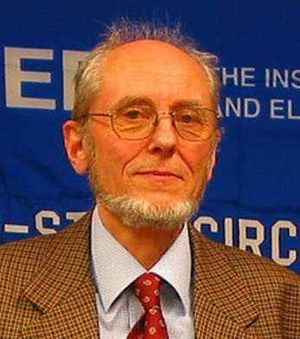Eric A. Vittoz: Difference between revisions
No edit summary |
No edit summary |
||
| (3 intermediate revisions by 2 users not shown) | |||
| Line 1: | Line 1: | ||
{{Biography | |||
|Image=Vittoz.jpg | |||
|Fields of study=Circuitry | |||
}} | |||
A renowned expert in low-power [[CMOS]] circuit design, Dr. Eric A. Vittoz also is recognized for his groundbreaking work with miniature electronic devices. His contributions at Centre Electronique Horloger (CEH) in Neuchâtel, Switzerland in the early 1960s advanced the development of the first electronic wristwatch. His work has fueled innovations including low-voltage CMOS logic; circuits based on MOS transistors operated in weak inversion, as bipolars and as pseudoresistors; and biology-inspired processing. With colleagues at the Swiss Federal Institute of Technology (EPFL) in Lausanne and CEH, he developed a MOS model for low-current and low-voltage circuit design known as the EKV model. His work has been applied to a wide range of battery-operated instruments. Dr. Vittoz is Research Fellow at the Swiss Center for Electronics and Microtechnology in Neuchâtel and a professor at EPFL. An [[IEEE Fellow Grade History|IEEE Fellow]], he has published more than 130 papers and holds 26 patents. | A renowned expert in low-power [[CMOS]] circuit design, Dr. Eric A. Vittoz also is recognized for his groundbreaking work with miniature electronic devices. His contributions at Centre Electronique Horloger (CEH) in Neuchâtel, Switzerland in the early 1960s advanced the development of the first electronic wristwatch. His work has fueled innovations including low-voltage CMOS logic; circuits based on MOS transistors operated in weak inversion, as bipolars and as pseudoresistors; and biology-inspired processing. With colleagues at the Swiss Federal Institute of Technology (EPFL) in Lausanne and CEH, he developed a MOS model for low-current and low-voltage circuit design known as the EKV model. His work has been applied to a wide range of battery-operated instruments. Dr. Vittoz is Research Fellow at the Swiss Center for Electronics and Microtechnology in Neuchâtel and a professor at EPFL. An [[IEEE Fellow Grade History|IEEE Fellow]], he has published more than 130 papers and holds 26 patents. | ||
| Line 9: | Line 9: | ||
[[First-Hand:Solid State Circuits Society First Hand Histories|Solid State Circuits Society First Hand Histories]] | [[First-Hand:Solid State Circuits Society First Hand Histories|Solid State Circuits Society First Hand Histories]] | ||
[[Category: | [[Category:CMOS integrated circuits & microprocessors]] [[Category:Current control]] [[Category:Voltage control]] | ||
[[Category: | |||
[[Category: | {{DEFAULTSORT:Vittoz}} | ||
Latest revision as of 18:40, 22 January 2016
Biography
A renowned expert in low-power CMOS circuit design, Dr. Eric A. Vittoz also is recognized for his groundbreaking work with miniature electronic devices. His contributions at Centre Electronique Horloger (CEH) in Neuchâtel, Switzerland in the early 1960s advanced the development of the first electronic wristwatch. His work has fueled innovations including low-voltage CMOS logic; circuits based on MOS transistors operated in weak inversion, as bipolars and as pseudoresistors; and biology-inspired processing. With colleagues at the Swiss Federal Institute of Technology (EPFL) in Lausanne and CEH, he developed a MOS model for low-current and low-voltage circuit design known as the EKV model. His work has been applied to a wide range of battery-operated instruments. Dr. Vittoz is Research Fellow at the Swiss Center for Electronics and Microtechnology in Neuchâtel and a professor at EPFL. An IEEE Fellow, he has published more than 130 papers and holds 26 patents.
Further Reading
Solid State Circuits Society First Hand Histories
